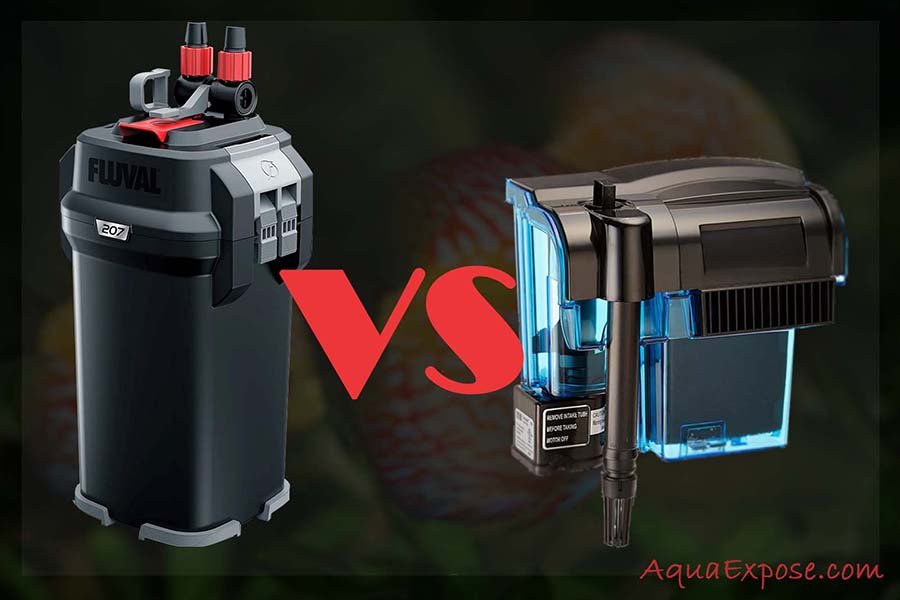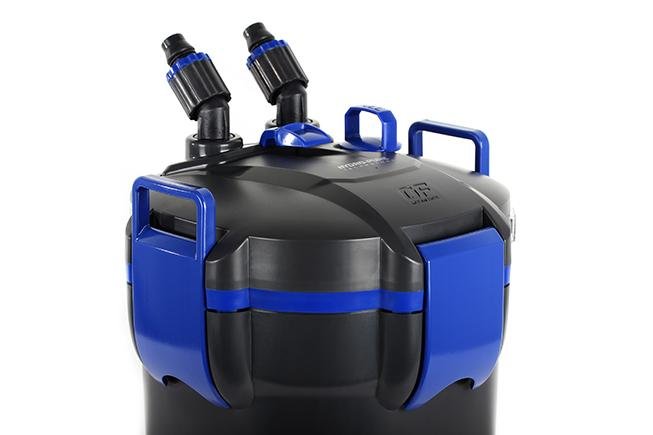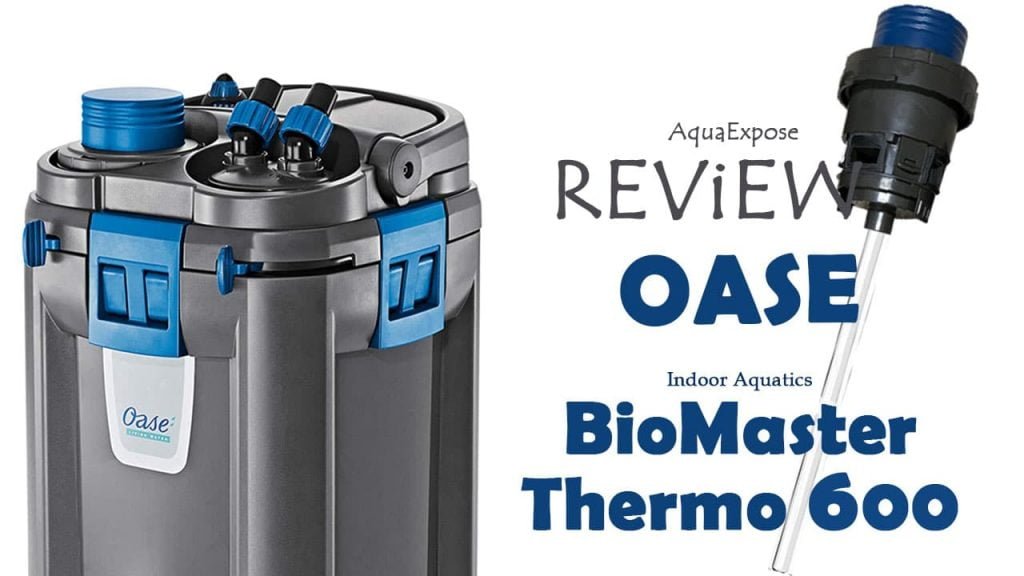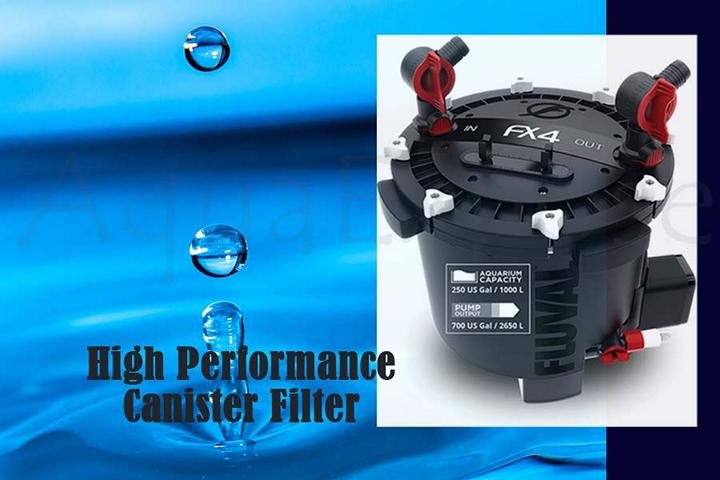Canister Filter VS Hang On Back (HOB): What Is The Main Difference & Which Is Best For Your Tank?

Aquarium filters come in all shapes, sizes and have their own way of working. So when you ask an aquarium keeper to choose the best between two aquariums, say Canister filter VS Hang On Back filter, in this case, you will never get a straight answer.
And why is that? Why is there no specific answer to which filter is the best?
Well, think of it this way: you have a tank with saltwater that needs specific filtration, but your friend’s aquarium with freshwater shouldn’t need that exact filtration. So, what should be the alternate question you ask them?
You have to ask them “Canister Filter VS Hang On Back filter – which is best for your aquarium?” So, let’s jump into the discussion to help you choose which is the best filtration for your aquarium.
Canister Filter VS Hang On Back Filter: Basic Differences
| Feature | Canister Filter | HOB Filter |
| Suitability | For large tanks (bigger than 100 gallons) | For small tanks (smaller than 100 gallons) |
| Price | Relatively high (average of $100-$300) | Relatively low (average of $20-$30) |
| Ease Of Use | A bit difficult | Really easy |
| Sound Creation | None | Deepens on the type you choose |
| Power | High | Low |
Overview: Canister Filter

Canister filters are self-contained systems that resemble a canister. The filters are external filters that are normally kept away from the tank itself. The filter is hidden behind a cabinet. As a result, it also contributes to the attractiveness of the aquarium.
The canister filter includes two tubes, one is for drawing the water in, and one is for outflowing the water. Water is taken into a tube, passed through the filter material, and then returned to the tank via the output tube.
For larger tanks, especially those above 100 gallons, canister filters are the best option. The only thing that enters the water in this system is two tubes (hoses) that may be expanded and relocated to any side of the aquarium. This enables maximal water flow, ensuring that almost all floating dirt, among other things, is collected up.
It’s also worth noting that a canister filter uses a pump to move water in and out of the filter media. The pump is usually incorporated into the system of canister filters, so you won’t have to buy one separately. With a canister filter, you also have the advantage of employing an integrated UV sterilizer rather than a standalone unit that takes up room in the aquarium.
How Does Canister Filter Work?
Depending on the user’s preference, a canister filter is placed outside of the water, often near the aquarium or under the tank. Each canister filter includes several hoses for cleaning the water within the tank.
The hoses can pull water towards the system from the tank. Then the water will be directed into the filtration. A variety of filter media. Will pressure the water as it reaches the system.
Once the water has been thoroughly filtered inside the system, the clean water is reintroduced to the tank through another hose. The residues and waste are collected in a specific container which is placed inside the system’s canister.
We have a fascinating article about the complete canister filter working procedure. You are able to read it. You are able to read it to learn what it does.
Types Of Filtrations
A canister filter is able to do all mechanical, biological, and chemical filtration. It’s important to note that, with the right medium, at the same time.
Biological Filtration: The high pressurization of water in this filter causes a lack of water and air contact, which can reduce biological filtration. However, this disadvantage is partially countered by the canister filter’s volume and ability to hold huge quantities of filter media.
By adding an extra-biological filter, the issue of lower biological filtration can be eliminated. When combined with a supplementary biofilter, Canister filters are becoming the best choice for both saltwater and reef aquariums.
Ultra Violet Purification: Ultraviolet purification can be added to canister filters to increase the overall quality of the tank water by purifying it with the help of UV radiation treatment, which kills algal spores and other bothersome pollutants.
They also offer a wider selection of filter media options. To ensure that the filtration your aquarium receives is effective, the media may often be altered, blended, and fed into canister filters in varied volumes.
Overview: Hang-On Back Filter

HOB filters are also known as power filters. These filters are usually made to be hung on the sidewalls or the back wall of your aquarium. With many aquarium kits, a HOB filter is generally included. It is also a very popular choice for beginners.
HOB filters are very simply built and simple to use. This system has only three components: an inlet tube, a spillway, and a pump. The entire system, including the top of the HOB filter, is always visible.
How Does HOB Filter Work?
There are no hoses included with a HOB filter to extract water out from the aquarium. Simply hang it on any of the walls of the fish tank, and it will use a lift tube and a tiny pump to pull water.
HOB filters have an inbuilt filter cartridge, which holds the purification materials. Once the water enters the filter, it is purified using a combination of filter media. Then the water is pumped back inside the aquarium via a spillway once it has been properly filtered.
Types Of Filtrations
A HOB filter will filter mechanically, biologically, and chemically. It all relies on the item you purchase. There are various approaches for each type of filtration. For example:
- Power Filters use conventional floss or foam for simple mechanical filtering.
- Chemical filtration is performed with activated carbon.
- Biological filtration is accomplished using the surface areas of the filtration system, which substantially increases the growth rate of beneficial bacteria.
Chemical filtration is performed with activated carbon, while biological filtration is accomplished using the surface areas of the filtration system, which substantially increases the growth rate of beneficial bacteria.
Greater modern filters come with more space for customers to add different resins for different chemical filtration, including bio-wheels for optimal surface area. This means your aquarium has more beneficial bacteria that will foster the amount of biological filtration.
Why Canister Filter Is Better Than Hob Filters?
There are various reasons why the canister filter is better than the HOB filter. Those are:
- Canister filters are best at all three kinds of filtration e.g., mechanical chemical biological, but the HOB is not ideal for biological filtration.
- The canister filter allows the integration of external plumbs but the HOB filter doesn’t.
- The canister filter doesn’t make any noise, but some version of the HOB filter does.
- Higher water flow efficacy compared to the HOB filter.
Pros And Cons Comparison: Canister Filter VS Hang On Back Filter
Now that we know the basics of how each filter works, weighing the overall pros and cons of each filter, will help you conclude which one suits your needs more.
Canister Filter Pros
These are the best filters in the market. And here are the features that contribute to that title:
- Best for aquariums with plants, saltwater, and reefs. Because all 3-kinds of filtration offered by it ensure every kind of water purification.
- Canister filters are a definite must-have if you have a planted or saltwater aquarium. All three types of filtering systems benefit from their exceptional filtration capability. As a result, it’s great for large tanks as well.
- The majority of these filters are extremely silent, particularly when hidden in a cupboard.
- Canister filters are large enough to hold multiple biological filtrations. As a result, it promotes bacterial development and aids in the proper maintenance of tank water.
- Canister filters are simple to maintain and repair if an issue arises.
- The integrated heater can be easily installed within this. As a result, you can keep the temperature of the water warm without having to install any additional heater. For example, Oase BioMaster Thermo.
- You can add UV purifiers to keep the water clear.
- Large and communal tanks benefit from canister filters. It has a good capacity for managing water flow.
- Also, Canister filters increase the oxygen in the tank water.
HOB filters have their charms, especially for a beginner. Here are some of the highlights of this filter:
Canister Filter Cons
The cons of the canister filter are very few if compared to the pros. These are:
- You need extra space beside or under your aquarium for extra space.
- In some cases, the extreme flow might be causing you more trouble than good, especially if your tank is smaller.
- The setup procedure is pretty tricky, especially if you are a beginner. You might also need to break a sweat for maintenance.
HOB Filter Pros
- HOB filters are exceptionally long-lasting and need little to no maintenance.
- A HOB filter can be extremely simple to use. If you keep it at arm’s distance while standing next to the aquarium, then you will be able to work on the maintenance if needed instantly. All you have to do now is just unplug it and remove it from the aquarium.
- These filters are inexpensive.
- HOB filters are preferable for tiny tanks because they can be hidden by hanging them on the rear wall of the tank.
- If you hear any noise coming out of it, as merely pushing down the loosened lid can heal it, it’s not serious.
- The HOB filters are straightforward to set up and use. These filters are compatible with plug-in features and play functionality. As a result, beginners will have no trouble installing and using it.
- It filters biologically, chemically, and mechanically. It even offers room for further chemical filtration.
HOB Filter Cons
HOB filters are usually great, but some of these cons might make you second guess whether you want to invest in one or not:
- The water flow is very low. You might need two HOB filters for one aquarium.
- It’s not ideal for biological filtration as it has very little space for beneficial bacteria to grow.
- The inlet tubes are very easy to break while cleaning. It needs extra precaution.
How Do Canister Units Compare To Other Aquarium Filtration Methods?
Well, from the pros comparison, you already know how canister units are different from HOB filters. However, its intriguing features and customizable technique for maintaining the purity of tanks’ water make it more admirable in comparison to other filtration methods. Some of these features are:
- This method allows for a significantly greater filtering area than typical, reducing the likelihood of clogs.
- It can perform cleaning and other management of these filters without causing discomfort to the tank’s occupants.
- You can also customize this filter to carry your water heater, diffusers, and other sorts of external plumbing.
Canister Filter VS Regular Filter
We just learned how canister units are compared to other filtration systems. Apart from all these, the fact that the canister filter takes up no space in the aquarium contributes to many of its advantages. So, there is no comparison of a canister filter to regular filters, which at the very least occupy space inside the aquarium.
FAQ:
Q: Among canister and HOB filters, which filter is best for biological filtration?
A canister filter is better for biological filtration.
Q: Which is a beginner-friendly filter among Canister and HOB filters?
HOB filter is a beginner-friendly filter.
Q: Which filter has the most filtration media and versatility?
The canister filter has the most filtration media and versatility.
Q: I have an exact 100-gallon tank. Which filter should I invest in?
It’s safe to invest in a canister filter if you have a 100-gallon water tank.
Conclusion
So now tell me, in the battle of Canister filter VS Hang On Back filter – which is best for your aquarium? Well, it is clear. If you are a newbie with a smaller aquarium and need a filter with a one-step installation, the HOB filter is for you. But if you want the best of all worlds for your large tank, the canister filter is for you.








